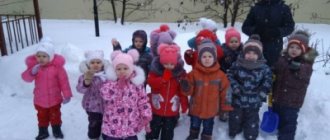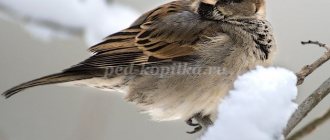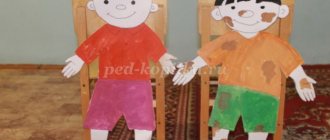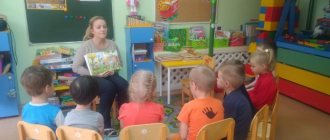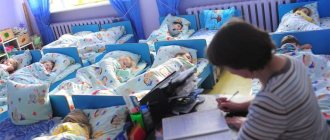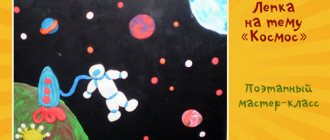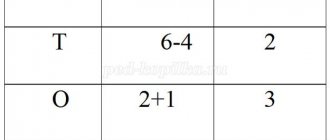General standards and requirements for preschool educational institutions according to SanPin
The activities of preschool educational institutions are strictly regulated by a list of rules established by the chief state sanitary doctor of the Russian Federation.
The list of instructions is approved by a resolution of the said official in the form of Sanitary and Epidemiological Rules and SanPiN Standards.
This SanPiN was adopted in 2013, but periodically undergoes some changes and additions.
Regarding walks, the document indicates advisory, not mandatory requirements . Nevertheless, the management of kindergartens tries to follow the advice of the country's chief doctor as closely as possible.
There are no rules in SanPin dedicated to time in the fresh air. Standards for the process of organizing walks are found in various sections. But regarding the organization of the kindergarten territory, the rules are quite clear.
Strict guidelines have been established regarding the level of landscaping (at least 50% and at least 20% for special densely populated areas and regions of the Far North), the level of air purity, and distance from noisy roads and highways.
The responsibility of the administration of the institution has been established to allocate play areas, areas for physical education and places for walking. At the same time, according to the sanitary doctor, public gardens and parks can be used for these purposes. The sites must have a dust-free coating that is harmless to children. It's best if it's grass. Each site should have a canopy or veranda for shelter from bad weather and precipitation.
How long should you spend in the fresh air?
In accordance with the requirements, walks in kindergartens should take a total of three to four hours daily . Moreover, this time interval is set without indicating the age of the students.
Therefore, this recommendation applies to all groups. SanPiN clarifies that the mentioned period must be divided into two times. Most often, children walk in the gardens in the morning and evening.
Temperature
Walks are provided all year round, both in warm and cold seasons. The rules establish advisory ranges for permissible temperatures. The document does not prohibit the organization of walks at temperatures above or below the established ones, since this norm is advisory.
Educators are required to objectively assess weather conditions and make decisions about going outside with children in accordance with what is happening outside the window.
At what temperatures are children not allowed to go for walks?
The maximum permissible temperature for walking in kindergartens is not established by the current SanPiN. Section XI of the document, or more precisely clause 11.5, states that in winter, when the air temperature is below -15ºC, the time spent outside must be reduced.
There is no talk of canceling the walk. The maximum permissible positive temperatures are not mentioned at all in SanPiN.
It is worth noting that in the previous edition of the rules from 2010, the doctor set temperature limits below which preschoolers were prohibited from walking. At what temperature should children not go for a walk? Thus, for children under four years of age, walks were prohibited in windy weather at temperatures below 15ºC, and for older children (5-7 years old) at minus 20ºC and below.
Educators have the right to independently determine the possibility and duration of spending time outside. The climate zone and the property supply of the garden are taken into account, that is, the presence of covered heated verandas. It should be noted that teachers are trying to play it safe once again and not go out for a walk on frosty days.
Other weather conditions
As noted above, the rules do not limit preschoolers from walking depending on weather conditions . The document does not contain a ban on outdoor activities, even in the presence of wind or precipitation. The decision again remains with the teacher.
You send your child to kindergarten. What should you do and how should you act in certain situations that arise in this institution? You will find all the answers in separate articles on our website, and you will also learn about the rules and regulations in the preschool educational institution, including the requirements for ventilation, nutrition, the number of children in the group, filling out the morning filter (inspection) log and the air temperature in the room.
Card index of walks in August in the middle group of kindergarten
Summer walks in the middle group. August
Walk No. 1
Studying sand and soil Goal: remember the properties of sand and soil, their similarities and differences. Observation : Compare the color of dry and wet sand. Wet sand can be used to sculpt and build, but dry sand crumbles. Pay attention to the soil (earth, sand, clay)
, digging, loosening.
Clarify and consolidate knowledge about the properties of sand. Teach to determine these properties by appearance (by color)
, check by touch.
Ask if insects live in sand and soil, if plants grow. Conduct an experiment: plant a seed in the soil and sand. After a while, check where there are shoots. Literary word: Let the parents not be angry, That the builders will get dirty, Because the one who builds is worth something! B. Zakhoder Didactic game “What will I build from sand” - children tell what can be built from sand. Goal: to teach how to write sentences on a given topic. Exercises to develop fine motor skills: “Recognize by touch” - lay out a pattern on the sand, children should recognize it by touch. “Draw with your finger” - draw any design on wet sand. Labor assignments: Loosen the soil, dig sand. Individual work : Walk along the border of the sandbox. Goal: develop balance. Outdoor game “Don't stay on the ground.” Goal: develop dexterity, speed of reaction to a signal.
Walk No. 2
Observing the shadow Purpose: to understand the concept of “shadow”, the relationship between clouds and the sun for the appearance of a shadow. Progress of observation In sunny weather, sometimes large clouds float across the sky. To draw children's attention: when a cloud covers the sun, we all on earth find ourselves in the shadow. Poem by E. Shen, W. Shao-Shan “Shadow”: It’s good to meet Aunt Shadow on a hot day! Under the green foliage I met you. We danced in the shadows, We laughed in the shadows. It's good on a hot day to meet Aunt Shadow! Didactic game “Say kindly.” Goal: to teach how to form nouns with diminutive suffixes. Labor activity Collection of large waste on site. Goal: to encourage the desire to work, to do the work cleanly and accurately. Outdoor game “Owl” Purpose: to teach to perform actions on a signal, to work smoothly with your hands, to run in a certain direction; "Get in the circle." Goal: to develop an eye, the ability to balance one’s strength when throwing. Individual work Development of movements. Goal: improve running technique (naturalness, ease, energetic push-offs)
.
Walk No. 3
Watching the water Purpose: to remember with children about careful handling of water. Clarify ideas about the properties of water: it flows, has different temperatures; In water, some objects sink, others float. Progress of observation : Draw children's attention to the properties of water: liquid, flowing, can have different temperatures (it warms up in the sun, cold from the tap)
.
The water is clear, you can see everything in it. On a hot day, the water heats up quickly in the basin. The water in the pond, river, lake is heated, so in the summer people enjoy swimming. Observe how quickly the water splashed on the asphalt dries. With older children, determine which objects sink in water and which float. Offer to determine why they float or drown. Literary word: At sunset the pond sleeps. Circles float on the water - These are small fish Playing out here and there. E. Stewart Didactic game “Sinking - Swimming”. Goal: consolidate knowledge about the properties of objects, their weight. Activate the dictionary. “What kind of water?” - children describe water. Goal: to teach how to select relative adjectives. Exercise to develop fine motor skills: “Water games” - an inflatable pool or a large bathtub and a set of toys for games are taken out for a walk. Children launch boats, pour water into vessels, bathe dolls, etc. Labor assignments: Children wash all toys (which can be processed)
and lay them out to dry on the grass.
Individual work . Walk barefoot on wet grass and warm sand. Outdoor game : “The sea is agitated.” Goal: to develop imagination, the ability to express the intended image in movement.
Walk No. 4
Observing insects Goal: to consolidate knowledge about insects, their way of life, living conditions. Progress of observation : Consider how beetles crawl, some of them fly. Pay attention to the long mustaches of longhorned beetles. Show a ladybug, it crawls along your hand, spreads its wings, and flies off to look for food. Consider the butterfly, how it flutters, how it folds its wings, sits on a flower, crawls along it. Examine the anthill. What does it consist of? Twigs, bark, lumps of soil - all this was brought by little workers - ants. Small holes are passages. The ants are constantly scurrying about, and each one is carrying something. Ants are friendly guys. They never quarrel and take care of each other. Ants don't hurt anyone. For this, everyone respects them - both in the forest and in the field. Nobody touches them. And we will not interfere with them - let them work. Watch how the bees examine the flower and climb deep inside for nectar. Talk about the benefits brought by bees: during the summer they pollinate a huge number of flowers. Ask what insects eat and who eats them. What are the benefits and harms of them? What do insects need to live? Literary word: Near the path under the mountain ash, a spider spread a web, a thread of transparent web, and wound it around a fist. If a fly flies in, the web will tremble, And the hunter from ambush will come running for the prey... E. Stewart They look, of course, a bit small, But they drag everything they can into the house. Our guys are little ants, their whole life is connected with work. Didactic game “Onomatopoeia” (the teacher names the insect, the children pronounce the onomatopoeia)
.
Goal: to consolidate the pronunciation of individual sounds. “Guess by the description” - (the teacher describes the insect, the children guess)
.
Goal: to teach how to compose a descriptive story, develop attention, coherent speech, find similarities and differences. Exercises to develop fine motor skills: “Build an anthill” - build from dry blades of grass. Labor assignments: Build an anthill. Individual work : Crawling on a log. Outdoor game : “Snake”. Goal: to teach how to run, holding each other’s hands, accurately repeat the movements of the driver, make turns, step over obstacles.
Walk No. 5
Observing the length of the day. Purpose: to give an idea of the length of the day, what changes have occurred with the sun in the summer. Progress of observation Why does it get dark so late in the summer? We're already going to bed, and it's not that dark outside? Why in winter, when we are just leaving kindergarten, is it already dark outside and all the lights are on? Explain that both hot weather and long days in summer are due to the fact that our planet is now receiving more sunlight and heat. Didactic game “Who is bigger?” What summer day? (hot, cool, cold, warm, rainy, sunny, joyful, sultry, long, etc.)
Work activity: Cleaning up mowed grass.
Goals: to teach you to finish what you start; cultivate accuracy and responsibility. Outdoor game “Burners”, “Wolf in the Moat”. Goals: - teach to follow the rules of the game, act on the teacher’s signal; - develop dexterity. Individual work : development of movements. Goal: to develop and improve motor skills.
Walk No. 6
Observing the work of adults Goal: to consolidate knowledge of how to care for plantings in the garden and flower bed. Progress of observation : Pay attention to the fact that the plants in the garden and flower bed need to be looked after: loosen the soil, water. Observe how plants change in growth and develop, ask: “Why do you need to weed and thin out plants? What plants grow where? Literary word: Don’t be lazy, my shovel, There will be a dug up bed. We'll smooth out the bed with a rake, we'll break up all the lumps, and then we'll plant flowers, and then we'll water it with water. Watering can, watering can, lei, lei! Bed, bed, drink, drink! G. Lagzdyn Didactic game “Who needs what for work” - (children determine which items help people in different professions)
.
Goal: to consolidate children’s knowledge that tools help people in their work, to cultivate an interest in the work of adults, and a desire to work themselves. “Who can name the most actions” - the children list the actions of a gardener or gardener. Goal: to activate vocabulary with verbs. Exercise to develop fine motor skills: “Make a flower” - make a flower in the sand from multi-colored corks. Work assignments: Water the plants. Individual work : Hit the ball off the ground. Outdoor game : "Scarf". Goal: develop speed and agility. Progress of the game. Everyone stands in a circle, leading the circle with a scarf, placing it on the shoulder of one of the players and quickly running in a circle.
The one to whom the handkerchief was placed takes it in his hand and runs after the driver. Both of them are trying to take an empty seat. Walk No. 7
Forest gifts - mushrooms and berries Purpose: to consolidate children's knowledge about forest plants, remember the names of mushrooms - edible and poisonous. Observation : Explain how to pick berries so as not to spoil the entire bush. Pay attention to the beautiful shapes of mushrooms and their color. Looking at pictures of mushrooms. Show edible mushrooms and highlight their features. Be sure to pay attention to the poisonous mushroom - fly agaric. Literary word: Along the forest paths, There are many white legs. In multi-colored hats, noticeable from afar. Collect, don’t hesitate, This is... (russula)
.
V. Stepanov Didactic game “Wonderful Bag” - children feel dummies of mushrooms in an opaque bag and name them. Goal: to teach children to recognize objects by characteristic features, to develop tactile sensitivity. “Guess by the description” - the teacher describes a variety of mushrooms, the children guess. Goal: to develop the ability to compose a descriptive story, attention, coherent speech, find similarities and differences. Exercises to develop fine motor skills: “Put it on the sand” - lay out a mushroom and a berry on the sand using various corks. Games with molds and sand. Work assignments: Picking berries. Individual work : Walking with bends. Outdoor game : “Raspberry Berry”. Goal: to develop coordination of speech with movement. Progress of the game. Let's go into the forest for raspberries, (Children walk in a round dance, holding hands.)
Let's go into the forest, We'll pick up ripe berries, we'll pick them up.
(“They are picking berries.”)
The sun is high,
(They show the sun.)
And there is a path in the forest.
(They show the path.)
My sweet one,
(They run in a circle, holding hands.)
Raspberry.
"Where have you been?". Goal: develop coordination of speech with movements, work on speech skills. Progress of the game. - Legs, legs, (Children walk in place.)
Where have you been?
— We went to the forest to pick mushrooms. - What have you guys been working on? (They squat, “picking mushrooms.”)
- We were collecting mushrooms.
- And you, little eyes, helped? - We searched and looked, (They look from under the hand, turn left, right.)
We looked at all the stumps.
Walk No. 8
Watching the frog Goal: remember the appearance of the frog, its movements. Observation : Pay attention to the appearance of the frog, the color of its skin. Is it clearly visible among the grass? Is it easy to catch her? Tell them that frogs are useful animals and need to be protected. They destroy mosquitoes and flies. Ask them to think about why the frog jumps and not runs. Pay attention to the front and back legs (the back legs are longer than the front, which is why she jumps)
.
She jumps on land and swims in water. Literary word: Jumping frog, Jump to me without fear, I will not offend you, I will never knock you. Jump, jump, frog - Green shirt, We must live, Without harming each other. K. Rossetti Didactic game “Which frog?” Goal: to teach children to select relative adjectives. “Who can name the most actions” - children select verbs that characterize the actions of the frog. Goal: to activate vocabulary with verbs. Exercise to develop fine motor skills: “Treat for the frog.” Playing with sand - children “cook” porridge, “bake” Easter cakes for a frog. Labor: Make a grass house for a frog. I/r according to PHYS: Jumping on two legs with forward movement. Outdoor game : 1. “Musical guys.” Goal: to teach how to perform movements without interfering with each other. Progress of the game. Two cords are laid out in parallel on the ground - this is a “river”. Here the frogs will “swim”. Then:! (Children jump and say: “Kwa! Kwa!”)
It’s time for us to jump into the river.
You can swim until the morning! Kwa!” (They jump out of the “river.”)
It’s time to go to the shore!
Kwa! Kwa! (“They catch” mosquitoes.)
Catch the mosquito!
2. "Jumpers." Goal: teach children to jump on two legs while moving forward. Progress of the game. A circle is drawn on the ground.
One of the players stands in the middle - he is a tag. At a signal, children jump over the line of the circle and, if there is no danger of being stained, continue jumping on two legs to the center of the circle. Participants in the game try to dodge the tag and jump out of the circle in time. Anyone caught becomes a tag. Walk No. 9
Observation of different types of transport: Objectives: - to consolidate the knowledge that a person uses a bicycle, which does not require gasoline; - a person moves by rotating the pedals. Progress of observation : A bicycle is a form of transport. The word "bicycle" means "fast legs". In order to ride it, you need to pedal with your feet and keep your balance with the steering wheel. Invite the children to look at the bicycle. From the very first childhood, a bicycle has served me. It's better than any car, Doesn't need gasoline! I pedal and fly like a bird from the mountain. But, by the way, it’s very difficult to climb the hill! I don’t get discouraged for long, I press on the pedals. I may be a little tired, but I will become stronger! The teacher asks the children questions. What is the difference between a bicycle and a car? (The car is filled with gasoline.)
Why do you become stronger when you ride a bicycle?
(The muscles of the back and legs develop.) Literary word: I’m rolling on two wheels, I’m turning with two pedals, I’m holding on to the steering wheel, I’m looking ahead, I know there’s a turn soon. A road sign told me: The highway descends into a ravine. I'm idling, in full view of pedestrians. Labor activity Sweeping paths on the site, collecting garbage. Goal: to cultivate a desire to work. Outdoor game “Migration of Birds” Goal: continue to teach how to climb a gymnastic wall Individual work : development of movements. Goal: improve orientation in space, sense of balance. Walk No. 10 Observation of the wind. Goal: repeat the concept of “wind”. What happens to trees in windy weather. Progress of observation Observe how the trees sway and branches bend. Ask why the trees behave so restlessly. What kind of wind is blowing: cold or warm. With the children, remember the name of a strong wind that blows off the roof, breaks trees, knocks out windows and doors, in a word, destroys. (Hurricane.) Riddle: It is unknown where he lives. It swoops in and bends the trees. If he whistles, there will be tremors along the river. You're a mischief maker, but you won't stop! (Wind) Didactic game “Blow like the wind.” Goal: to develop the strength of the voice, the ability to take a deep breath through the nose, exhale through the mouth while pronouncing the sound u. Labor activity. Make a primitive weather vane, an airplane. Goal: to arouse interest in creation. Outdoor game “Above the Earth”. Goal: to develop dexterity and speed of reaction to a signal. "Blind Man's Bluff." Purpose: to train children in running and dodging, to navigate in space. Individual work Development of movements: “Outrun the wind” - running for acceleration. Goal: to develop and regulate running speed. Walk No. 11 Observation of beetles. Purpose: to introduce the beetle, its way of life, living conditions. Progress of observation : Consider how beetles crawl, some of them fly. Pay attention to the long mustaches of longhorned beetles. Help children identify common features in their structure: 6 legs and 4 wings. Riddle: Black, but not a bull, Six legs without hooves, When it flies, it howls, And when it sits, it digs the ground. (Beetle)
Poem by V.L.
Gaazov “Beetles”: There is a huge stag beetle, He is not too lazy to wear antlers. He scares his enemies with them and does not allow himself to be eaten. Beetle called "rhinoceros": Do you see the strong strong horn? For enemies it is a threat, but for a beetle it is an ornament. Didactic game “Guess by description” (the teacher describes the insect, the children guess)
.
Goal: to teach how to compose a descriptive story, develop attention, coherent speech, find similarities and differences. Labor activity. Clearing the garden of debris. Goal: to cultivate the desire to work together, to bring the work started to the end. Outdoor game . "Beetles." Goal: to teach how to run in all directions and change direction when given a signal. "Snake". Goal: to teach how to run, holding each other’s hands, accurately repeat the movements of the driver, make turns, step over obstacles. Individual work “Fun Jumping”. Goal: to consolidate jumping over two objects. Walk No. 12 Observation of mountain ash. This rowan, a branchy tree, grows almost everywhere, it also grows in our kindergarten, it loves light, grows as a tree, bears fruit abundantly, it is one of the people’s favorite trees and there are many songs and poems about it. What does the tree have? What trunk? (straight, there can be many trunks, the bark is brown, smooth, small oval leaves grow on the branches, there are denticles along the edges of the leaves, the leaves are arranged in pairs)
.
She is beautiful in the spring, in a white spring outfit, her small flowers emit a soulful scent, in the summer the berries slowly ripen under the rays of the sun, they are not tasty and birds do not peck them. In late autumn, rowan leaves turn yellow, red and fall off; orange-red clusters of fruit remain on the trees all winter. Literary word: Bunches of rowan trees burn in the sun, the rowan berries ripple in the children’s eyes. Rowan gave me a red berry. I thought it was sweet, but it tastes bitter. Either it’s a berry that’s just not ripe, or it’s a cunning rowan that wanted to play a trick. Didactic game : “Recognize a tree by name” - find the whole in parts, fix the names of the trees. Outdoor game : “Sly Fox” - develop running, attention, and ingenuity. I/r according to FISO: hitting the ball off the ground, rearranging the column at a signal. Work assignments: clean up the veranda.
We recommend watching:
Summer walk - excursion in kindergarten. Middle group Summer walk - a trip to the forest in kindergarten. Summary Card index of walks in June. Middle group Card index of walks in July in the middle group of kindergarten
Similar articles:
Walk watching the clouds. Middle group
Walk watching the sun in summer. Senior group
Observing insects in the older group in summer
Observation of a frog in the older group
When can you not go to kindergarten?
For schoolchildren, the Ministry of Education and each individual educational institution develop standards and make decisions to cancel classes if certain temperature limits are exceeded.
There is no such practice for kindergartens. That is, kindergartens are not closed at any temperature ; the institutions operate in any weather conditions.
Parents make the decision to visit independently, guided by their own capabilities and wishes. At the same time, there are several recommendations about under what conditions it is better not to take your child to kindergarten or go for a walk.
Helpful tips below:
- Pediatricians advise against long stays outside at temperatures below -15ºC for children under three years of age and below -20ºC for older children.
- In the case where the parents decide to leave the baby at home, it is recommended to notify the teacher about his absence. Otherwise, the child will not be excluded from the list for calculating daily meals, therefore, the amount will not be excluded from the monthly receipt.
- Absence from kindergarten for more than 5 days (weekends and holidays are not included) will entail the need to provide a certificate from a pediatrician about the child’s health condition.
- If your baby goes to kindergarten, you need to make sure to dress him warmly. So, doctors advise wearing several pieces of clothing, creating layers. This will ensure the presence of air between the layers, and it will retain heat.
- If a child travels to kindergarten in a car or bus, you need to try to prevent overheating. Otherwise, the baby will go out into the cold sweaty, which can lead to hypothermia and illness.
Unfortunately, on the territory of the Russian Federation there is no document clearly establishing the rules for conducting walks for preschoolers in kindergartens. However, we should not forget that educators go outside with the children and are able to adequately assess the possibility and duration of spending time in the fresh air.
